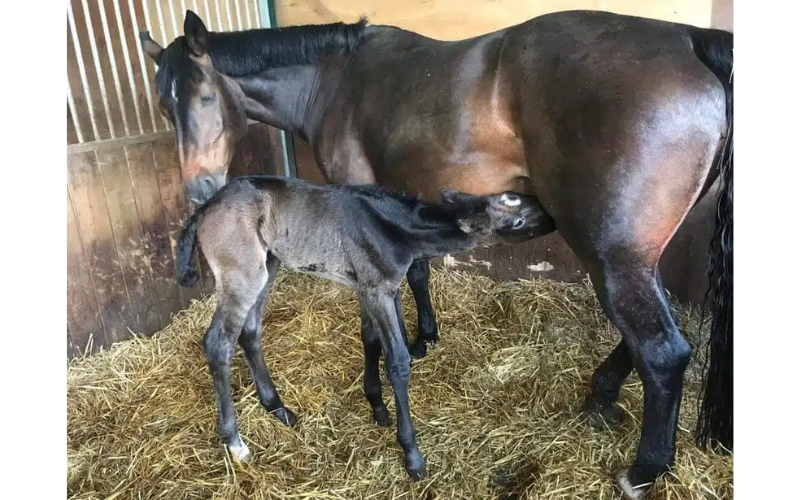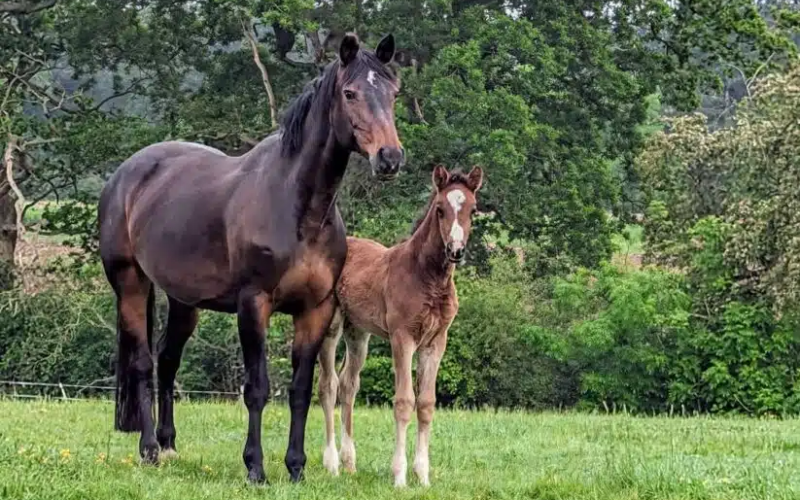Posted: 3rd June 2025 | Back to news feed


The foaling season is a hectic time for breeders. Providing proper support to the mare before conception, throughout her pregnancy, and during the nursing phase is crucial. In the final months of gestation, the mare’s nutritional needs will rise to ensure both her health and the foal’s development are met. During lactation, it is essential for the mare to have access to ample, high-quality nutrition to sustain both herself and her foal.
Feeding a Pregant Mare
Throughout pregnancy, a mare’s daily nutritional needs rise significantly. These essential nutrients are crucial not only for the mare’s own body maintenance but also for the healthy growth and development of her foal. After the fifth month of gestation, the mare’s requirements for energy and protein will escalate. This is particularly true in the final trimester, when the foal experiences its most rapid growth and development, leading to an increased demand for nutrients.
The mare’s body weight gradually increases during pregnancy. An increase during pregnancy is normal, however, it is important to avoid the storage of too much excess fatty tissue. But a pregnant mare should not be too thin either. It is therefore important to monitor increases or decreases of the mare’s body weight during pregnancy. Monitoring the broodmares body weight is also essential before pregnancy. Research has shown that the mare’s body condition can have an effect on the mare’s fertility (3). The mare’s body weight and condition can be estimated and monitored by using the Body Condition Score (BCS) scheme (4).
Energy and protein support the body during the last months of gestation and promote foal growth (2). However, feeding excessive amount of these nutrients does not result in increased foal growth or a larger foal at birth (5). As a result of feeding excessive amounts, the mare’s BCS will increase but the growth of the foal will not significantly increase. Therefore, it is important to feed the mare based on meeting her daily nutrient requirements.
The mare’s Vitamin A and E requirements are increased throughout pregnancy (2). Calcium and Phosphorus requirements, two minerals important for bone growth and foal development, increase after the 7th month of gestation (1). Therefore, after the 7th month of gestation the mineral intake of the mare should be increased. If the increased mineral requirements are not met, the mare will use her body stores to provide the foal with sufficient Calcium and Phosphorus (2). Besides, if the mare does not receive enough energy and protein to support herself and the foal, the body will break down fat and muscle tissue. This will result in the loss of muscle mass and causes the mare to lose weight (2).
Nutrition for the Pregnant and Lactating Mare - Synovium Horse Health
Feeding schedule of a pregnant mare
Roughage forms the basis of every diet and is therefore also essential for the pregnant mare. There are several types of roughage available (grass, hay, etc.) but the quality and amount of nutrients provided can differ between different types of roughage (6). It is important to provide the mare with roughage of the highest quality. A roughage analysis can determine the quality of the forage fed to the mare. If this is not possible, the quality can also be estimated by the smell, colour, the amount of dust or other dirt the roughage contains and the texture of the roughage (7).
Because the mare’s daily nutrient requirements do not change during the first few months of pregnancy, the amount of concentrates fed does not need to be increased. If the mare barely or does not exercise at all, sufficient high quality roughage combined with a vitamin and mineral supplement is enough to meet the mare’s daily needs (2). If the mare is actively being exercised, then the addition of extra concentrates is required to supplement the diet to provide the mare with sufficient nutrients (3).

Feeding Schedule of a Lactating Mare
High quality roughage is also essential during the lactation period. High quality forage is not only more palatable but also contains more nutrients which are important for the lactating mare. Often, during the lactation period fresh grass is available which is rich in essential nutrients (6).
Because roughage does not provide sufficient amounts of nutrients to meet the mare’s requirements, concentrates and supplements are added to the diet (9). Concentrates contain energy, protein, vitamins and minerals that supplement that support a well-balanced diet. In addition, concentrates contain several nutrients that provide the mare with different types of energy. For example, concentrates contain starch, fats and fibre, all of which are digested differently in the body and provide the mare with long- and short-term sources of energy.
If the mare requires additional energy during the lactation period, the diet can be supplemented with Linseed oil. Mainly for mares that are difficult to maintain their weight, Linseed Oil is the ideal addition to the diet. Synovium Linseed Oil is a vegetable oil and contains the right balance of Omega-3 and Omega-6 fatty acids. The fatty acids in Linseed oil offer the mare a long-lasting source of energy because it is slowly metabolized in the body. As a result, Synovium Linseed Oil provides extra energy without the addition of too much sugar and starch.
Especially during the first weeks of the lactation period, the nutrient requirements increase significantly. Feeding general concentrates does not contain enough energy, proteins, vitamins and minerals to meet the mare’s increased requirements. Therefore, it is advised to feed concentrates specifically formulated for the mare’s increased requirements or a vitamin and mineral supplement can be added to the diet to meet the mare’s daily needs. Synovium Prefit is a vitamin and mineral supplement that contains the essential vitamins and minerals and is the perfect addition to the diet of the pregnant or lactating mare.
Because proper nutrition and feeding the right nutrients in the right amount is important for the mare but also for the foal, it is advisable to ask a nutritionist for advice before or during the gestation and lactation period.
For more information head to www.synovium.co.uk
References
1. Robles, M., Hammer, C., Stanair, B., Chavatte-Palmer, P. (2021) Nutrition of Broodmares.
Veterinary Clinics of North America: Equine Practice, 37(1):177-205.
2. Lawrence, L.M. (2013) Chapter 11 – Feeding stallions and broodmares. In: Geor, R.J.,
Harris, P.A., & Coenen, M., (Eds.). Equine Applied and Clinical Nutrition. Saunders
Elsevier: China.
3. Morley, S.A., Murray, J.A. (2014) The Effects of Body Condition Score on Reproductive
Physiology of the Broodmare: A Review. Journal of Veterinary Science, 34(7):842-853.
4. Carroll, C.L., Huntington, P.J. (1988) Body condition scoring and weight estimation of
horses. Equine Veterinary Journal. 1988;20(1):41-45.
5. Kubaik, J.R., Evans, J.W., Potter, G.D., Harms, P.G., Jenkins, W.L. (1988) Parturition in the
multiparous mare fed to obesity. Journal of Equine Nutrition, 8(2):135-140.
6. Mitchell, B. (2015) Feeding the pregnant mare. Equine Health, (26):12-15.
7. Harris, P.A., Ellis, A.D., Fradinho, M.J., Jansson, A., Luthersson, N., Santos, A.S., Verveurt,
I. (2016) Review: Feeding conserved forage to horses: recent advances and
recommendations. Animal, 11(6):958-967.
8. Gibbs, P.G., Potter, G.D., Blake, R.W., McMullan, W.C. (1982) Milk Production of Quarter
Horse Mares During 150 Days of Lactation. Jounral of Animal Science, 54(3):496-499.
9. Donoghue, S., Meacham, T.N., Kronfeld, D.S. (1990) A Conceptual Approach to Optimal
Nutrition of Brood Mares. Veterinary Clinics of North America: Equine Practice, 6(2):373-
391
The Equestrian Index newsfeed is compiled from articles submitted by advertising members and expresses the opinions of those members. Watsons Directories Ltd shall not be held liable for any inaccuracies or mis-statements therein.